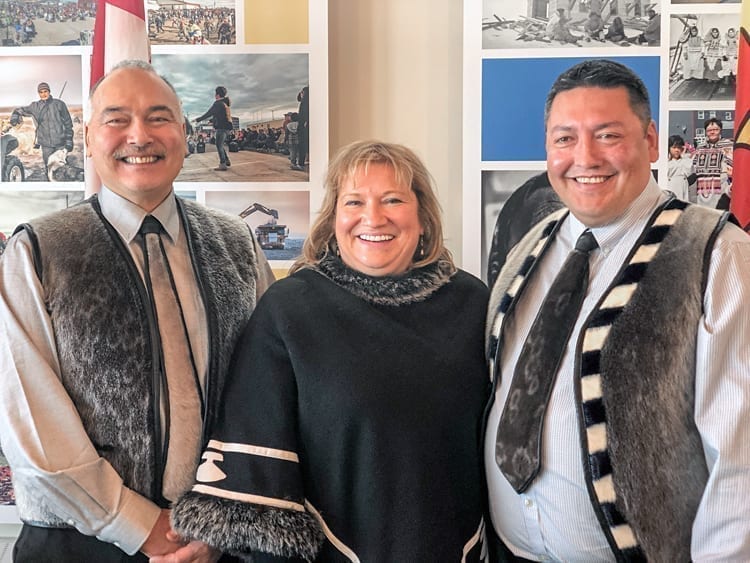A feasibility study on plans to extend renewable power from northern Manitoba into Nunavut received a major boost with the announcement that the federal government was kicking-in with a $1.6-million grant to the Kivalliq Inuit Association (KIA) on Feb. 25.

The announcement was made by Parliamentary Secretary to the Minister of Intergovernmental Affairs, Northern Affairs and Internal Trade Yvonne Jones, on behalf of Minister of Innovation, Science and Economic Development Navdeep Bains.
The project being studied would see a transmission line run about 1,200 kilometers to Rankin Inlet from Churchill, Man. and would include a fibre-optic cable.
KIA president David Ningeongan said the KIA had an engineering firm out of Montreal (BBA) do an initial study in 2015 that indicated the project would be feasible.
He said the $1.6 million the feds committed to the project will help the KIA enhance the 2015 study and it will also allow the organization to commence early-phase engineering and permitting work for the transmission line as it prepares for community consultations both north and south of 60.
"We've got a lot of work to do within the next 12 months and the commitment is that we'll have used all the money from the feds by this coming March," said Ningeongan.
"We've also committed $800,000 on top of the $1.6 million to get us to the next level with this project.
"We don't have any timelines, as yet because we're working on them as we speak."
Ningeongan said the project is totally Inuit-led and the KIA has the support of the federal government and the Government of Nunavut (GN), but it still has to fully engage with Manitoba.
He said Manitoba did a similar study in 1999, so its government knows what infrastructure is needed within the transmission line the KIA is trying to forge ahead with.
"I anticipate every level of government will be fully engaged with this project within the next 12 months, but we're still too early in the crawling stage to really say who is and who isn't, doing what.
"But the KIA is going to continue to push this ahead as an Inuit-led project – not a provincially- or territorially-led project.
"The Manitoba government is aware of the project as, in previous months, we've engaged with Hydro Manitoba as well as the Department of Crown Services just to let them know we're going to try and get this project off the ground – we just haven't fully engaged with them to see how fast we're going to move the project."
Ningeongan said the plan for both the transmission line and the fibre link is for Arviat, Whale Cove, Rankin Inlet, Chesterfield Inlet and Baker Lake to all be connected, with the hope there will be enough line in the system to allow them to get to Coral Harbour and Naujaat with the fibre-optic line.
He said the initial project is to get the five communities online with the transmission power system and then work toward trying to have all seven Kivalliq communities eventually connected.
"I don't know how soon that would be for all seven, but the first five communities would be connected for both at the same time.
"Right now we're trying to get the dates and timelines identified and I expect to be able to share them with the media within the next 10 months."
Ningeongan said there seems to be a good level of support for the project in the nation's capital, as it's a green project for Nunavut and it's the first of its kind.
He said the Kivalliq Hydro-Fibre Link project will represent the first time southern Canada connects to the North on any kind of infrastructure project.
"This is a nation-building project and the KIA looks forward to continuing its relationship with federal, territorial and provincial governments to move it ahead.
"This project has been discussed for many years but (KIA executive director) Gabriel Karlik and I have been pushing very hard since both the GN and the Government of Manitoba put funding into a study in 2015 which went nowhere after being completed.
"We began pushing even harder in 2017 to get this project off the ground and the KIA found a private-development partner (Anbaric Development Partners) that's backed by the Ontario Teacher's Pension Plan.
"The KIA's partner has the background for transmissions and other green-energy files within the U.S.A. and that's helped to allow us to move this project forward to where we've got the momentum to see it through within the next 12 months."
Ningeongan said if the Kivalliq Hydro-Fibre Link project goes ahead, it will save 380,000 tones of greenhouse gas emissions in Nunavut and the GN is projected to save $40-million annually in fuel costs.
He said industry would also benefit greatly, with Agnico Eagle saving about $60-million a year with the transmission line in place.

"That's $100-million saved right there and that doesn't include the potential future savings of our commercial users – Northern stores and Co-op stores – which, I would hope, with lower power rates, would decrease item prices and have a positive impact on people in the region.
"The fibre optic, in itself, will be a game changer by providing higher user speeds that will help the health-care system access online support from different facilities across Canada.
"And, for education, Inuit and non-Inuit alike will have the opportunity to take online courses without having to worry about satellite bandwidth cutting their service when they need it the most.
"And, if we do get the fibre-optic line, the satellite bandwidth will open-up to the other communities in the territory, which should improve the speed services and provide a lasting benefit to all of Nunavut, not just the Kivalliq region."